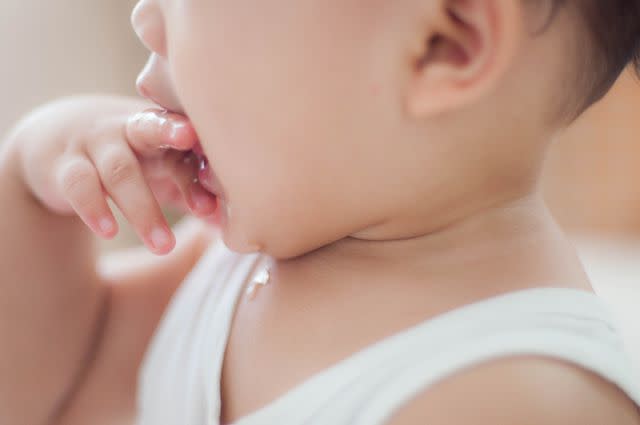What Is a Drool Rash?
A Common Skin Irritation in Babies

Medically reviewed by Susan Bard, MD
Drooling is a natural part of a baby's life when developing salivary glands and teething, but drooling can cause problems when it leads to a rash. Drool rash symptoms can be treated at home in most cases, but symptoms do tend to return during this life stage.
In this article, you will learn more about what is a drool rash, including its symptoms, causes, and treatment options. You will also learn when to call a healthcare provider for a drool rash.

Karl Tapales / Getty Images
Drool Rash Symptoms
Drool rash symptoms include:
Skin irritation and redness
Flat patches or slightly raised patches
Tiny red bumps
Drool rash symptoms can appear on the following:
Lips and mouth area
Chin
Cheeks
Chest or neck
Your baby will likely begin drooling between 2 and 3 months old, when their salivary glands develop. This means symptoms can start even before teething begins. Some babies take more time to develop, so drooling can be expected to start anywhere between 2 and 6 months old.
Drool rash symptoms will become noticeable during this time and may last for weeks, despite your best efforts to reduce symptoms.
Related: A Guide to Infant Teething
Causes
Drooling causes drool rash in nearly all infants and young children. This is because the constant moisture, or wetness, on the skin from drooling causes irritation and rash. It is also because wiping or dabbing the drool with a cloth, shirt, or blanket can cause further irritation to an infant's incredibly delicate skin.
Repeat friction from wiping or trying to dry the drool can also increase discomfort in the area and may increase the risk of rash infection if the skin breaks.
Causes of drool rash include:
Drooling from salivary gland development or teething
Using a pacifier
Having food on the face
Irritation from wiping drool or wiping food from the face
Stopping drool rash is not the same as stopping the cause of drool rash, though, because drooling serves an essential purpose for your baby. Drooling serves the following purposes:
Keeps baby's mouth moist, making it easier to swallow
Softens and moistens food (once solid are part of your baby's diet)
Washes or carries away food residues
Protects your baby's new teeth against tooth decay
Contains enzymes that help with digestion
Related: What Is a Teething Rash?
Diagnosis
If you can tell the rash is caused by drooling, you can move on to treating the drool rash at home. However, there are times when talking to your pediatrician is recommended for drool rash. You may want to consider consulting with your pediatrician in these circumstances:
If you're not sure your baby's rash symptoms are caused by drool
If you see other symptoms in addition to drool rash
If the rash cracks or splits open and your baby is in pain
If the rash doesn't show any improvement after roughly a week of home treatment
Does Drool Rash Ever Cause an Emergency?
Drool rash is typically nothing to worry about. If you see the following signs of emergency in your infant or young child, it's time to call for immediate medical support. Signs it's time for assistance from a healthcare provider or emergency provider include:
High fever
Fatigue or lethargy
Stiff neck
Sensitivity to light
Neurological changes (i.e., they seem confused)
Skin color changes (i.e., paler than usual or turning blue)
Difficulty breathing
You are concerned about the rash or symptoms and don't know what to do next
It's important not to ignore these signs as they can indicate a serious condition known as meningitis (inflammation and infection of the protective membranes of the brain and spinal cord).
Treatment
Treating drool rash aims to support the skin's natural healing process and remove any repeat irritation source.
Drool rashes that are common after a baby starts eating solid food are best treated with regular, gentle face washing after meals or after the baby spits up.
You can use a soft cloth and warm water to wipe away any remaining food particles that can create irritation and rash. After you finish, ensure the face and chest area are dry. Using a bib during meal times can also help protect the chest area from food particles and drool.
Is Vaseline Good for Baby Drool Rash?
If your baby or child doesn't have skin sensitive skin or allergies and your pediatrician recommends it, you can use Aquaphor cream or a petroleum jelly such as Vaseline to help protect the skin. This method may also help prevent future drool rashes.
To avoid further skin irritation, you may also want to consider how often you're bathing the baby and what laundry detergent you use to wash their clothes. A bath twice or three times a week is sufficient. Extensive skin care regimes are not necessary or recommended for babies.
Baby skin is highly absorbent, so it’s crucial to use fragrance-free, hypoallergenic products (products unlikely to cause an allergic reaction) and avoid perfumes and dyes, which can irritate newborn skin.
Related: Skin Rashes Types and Causes in Children
Summary
Baby drool rash is common in babies, especially when they are developing salivary glands or getting teeth. Baby drool rash can cause symptoms around the lips and mouth, cheeks, and down the neck to the chest in some cases. Symptoms include patches of flat or raised skin irritation and tiny bumps.
Diagnosis can be done by a pediatrician if you're not certain that drool is causing the rash or if the rash keeps coming back. Treatment includes keeping the face, neck, and chest area clean and dry and also using cream or petroleum jelly, if so advised.
While a drool rash is a common occurrence in most children, it's important to note any additional signs and symptoms like fever or lethargy that require further medical attention. When in doubt, contact your pediatrician.

